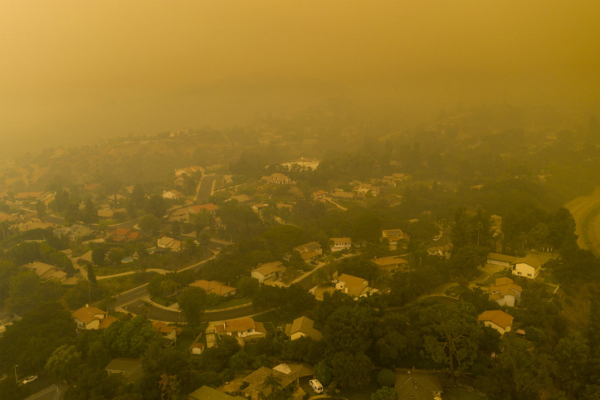
One surprising effect of wildfires: Itchy, irritated skin

Are you finding yourself with itchy, irritated skin that you can’t stop scratching? Or have you wondered why your child’s eczema is suddenly worse and so hard to control? Mounting evidence suggests that wildfires, which are increasing in intensity and frequency, contribute to skin problems, including eczema flares.
What is eczema?
Eczema is a common chronic skin condition that affects about one in 10 people in the US. Its hallmarks are inflamed and dry, itchy patches of skin.
Atopic dermatitis is the most common type of eczema. It can run in families, often beginning in childhood. Typically, in the northern hemisphere, it grows worse during the winter season when the weather is cold and drying. Now some experts are seeing that pattern change. At Massachusetts General Hospital, for example, one dermatologist noted an unusual spike last summer in patients with flare-ups of eczema.
Why is eczema getting worse during summer?
In 2023, Canada experienced more than 6,000 wildfires that burned over 16 million hectares of land — an area larger than the entire state of Georgia. While far away from the devastation, the smoke reached across the US and more than 2,000 miles to Europe. Poor air quality from these distant wildfires caused eye and throat irritation and difficulty breathing.
In Boston, Dr. Arianne Shadi Kourosh, a dermatologist at Massachusetts General Hospital, also began to notice skin symptoms. Normally the dermatology clinics would see fewer than 20 people during a summer month for eczema, including atopic dermatitis. Suddenly that jumped to 160.
Looking back at summer month records from the last four years, her research showed that the number of visits for these skin complaints tracked with the severity of air pollution. These findings are consistent with other research noting an uptick in eczema flares and psoriasis flares associated with wildfire pollution. But why?
Researchers theorize that airborne pollutants might set off a cascade of effects within the body by activating an oxidative stress pathway. This damages the skin barrier and prompts an inflammatory response. This cascade also may play a role in the development of eczema.
What can you do to protect your skin?
Air pollutants in wildfire smoke may harm multiple organs — not just your heart and lungs, but also our skin, it seems. So, when outdoor air quality is bad due to wildfires, limiting your exposure can help reduce health risks. While we can say the same for industrial air pollution, wildfire pollution is likely worse due to its additional toxic particles.
- Seek help if you’re itching. Check with a dermatologist or your health team if you think wildfire smoke or other forms of air pollution might be affecting your skin.
- Check local air quality.AirNow.gov shares local, real-time air quality information and activity guidance. When recommended, stay indoors if possible. Shut doors, windows, and any outdoor air intake vents.
- Protect your skin. When you’re outdoors, wear a mineral-based sunscreen containing zinc or titanium. While most other sunscreens work through a chemical reaction to absorb the ultraviolet (UV) rays that damage skin, zinc and titanium sunscreens help by forming a barrier over skin that reflects off UV rays. The barrier also reduces the amount of pollutant particles getting to the skin to set off the inflammatory cascade. Wearing sunscreen protects against skin cancer, as well.
- Wash up. After coming back inside, cleansing your skin and applying a hypoallergenic moisturizer will help keep it healthy. If you do have eczema, choose cleansers and moisturizing products recommended by your dermatologist or health care provider.
About the Author

Wynne Armand, MD, Contributor
Dr. Wynne Armand is a physician at Massachusetts General Hospital (MGH), where she provides primary care; an assistant professor in medicine at Harvard Medical School; and associate director of the MGH Center for the Environment and … See Full Bio View all posts by Wynne Armand, MD

The cicadas are here: How’s your appetite?

You’ve probably heard the news: Cicadas are coming. Or — wait — they’re already here.
And are they ever! Due to an unusual overlap of the lifecycles of two types (or broods) of cicadas, trillions of cicadas are expected to emerge in the US by the end of June, especially in the Midwest.
If you’d like to see where they’ve already arrived, track them here. And if you’re wondering if this cicada-palooza could help with grocery bills, read on to decide for yourself how appealing and how safe snacking on cicadas is for you. The pros and cons could change your outlook on the impending swarm.
What to know about cicadas
Don’t worry, cicadas are largely harmless to humans. In fact, their appearance is welcome in places where people routinely snack on them as a low-cost source of calories and protein.
Estimates suggest up to two billion people regularly eat insects, especially in South and Central America, Asia, Africa, Australia, and New Zealand. Cicadas, when available, are among the most popular. And if you thought no one in the US eats cicadas, check out this video from a May 2024 baseball game.
Are you tempted to eat cicadas?
For plenty of people, cicadas aren’t the food of choice. Some people can’t get past the idea of eating insects as food. That’s understandable: after all, the culture in which we are raised has a powerful influence on what we consider acceptable in our diets. Something some Americans might find off-putting (such as eating snakes) is common in China and Southeast Asia. Meanwhile, people outside the US find aspects of the typical Western diet unappealing (such as root beer, peanut butter and jelly, and processed cheese).
But some people shouldn’t eat cicadas because it could be dangerous for them.
Why you should — or shouldn’t — eat cicadas
Eating cicadas is common in many parts of the world because they are
- nutritious: cicadas are low in fat and high in protein, including multiple essential amino acids
- inexpensive or free
- tasty (or so I’m told): descriptions of their flavor vary from nutty to citrusy to smoky and slightly crunchy.
In years when cicadas emerge, recipes for dishes containing cicadas emerge as well.
Then again, there are several good reasons to avoid making cicadas a part of your diet, including these:
- You just can’t get past the “ick” factor. Adventurous eaters may be willing to try or even embrace consuming cicadas, while others will be unable to view the idea as anything other than horrifying.
- You find the taste or consistency unappealing.
- You’re “cicada intolerant.” Some people get stomach upset, nausea, or diarrhea if they eat too many cicadas.
- You’re pregnant or breastfeeding, or are a young child. Concerns about even low levels of pesticides or other toxins in cicadas have led to recommendations that these groups not eat them. Doesn’t this suggest the rest of us should also steer clear? Well, thus far, at least, there’s no evidence that toxins in cicadas are causing health problems.
But there is one more very important entry on this list: people with a shellfish allergy should not eat cicadas. Odd, right?
The shellfish-cicada connection
Cicadas are biologically related to lobsters, shrimp, crabs, and other shellfish. So if you’re allergic to shellfish, you might also be allergic to cicadas. A particular protein called tropomyosin is responsible for the allergy. It’s found in shellfish as well as in many insects, including cicadas.
The allergic reaction occurs after eating the cicada. Just being around them or handling them won’t trigger a reaction.
Among people with a shellfish allergy, developing a reaction after eating cicadas could be a bigger problem than it seems: up to 10% of people have shellfish allergies and, as noted, insect consumption is common worldwide.
Is it okay for your dog or cat to eat cicadas?
Walking your dog after the emergence of cicadas can be a new and exciting experience for you and your pet! Dogs may chase after cicadas and eat them. Cats might, too, if given the chance. That can be a problem if your pet eats too many, as some will experience stomach upset or other digestive problems.
While the insects are considered harmless to dogs, the American Kennel Club says it’s best to steer them away from cicadas once they’ve eaten a few.
Which other insects trigger allergies?
While insect-related allergic reactions (think bee stings) and infections (like Lyme disease) are well known, the insect-food-allergy connection is a more recent discovery.
One recently recognized condition is the alpha-gal syndrome, in which a person bitten by certain ticks develops an allergy to meat. The name comes from a sugar called galactose-α-1,3-galactose (or alpha-gal) found in many types of meat including beef, lamb, pork, and rabbit. According to the CDC, up to 450,000 people in the US may have developed this condition since 2010.
There aren’t many rigorous studies of the overlap of insects and food allergies, so there are probably others awaiting discovery.
The bottom line
When it comes to eating cicadas, I’ll pass. It’s not because of the risks. I’ve never had a problem with shellfish, and for most people the health risks of eating cicadas seem quite small. It’s just unappealing to me, and I’m not a particularly adventurous eater.
But let’s go easy on those who do enjoy snacking on cicadas. Insects offer a good source of calories and protein. Just because eating them seems unusual in the US doesn’t make it wrong.
So, if you like to eat cicadas and have no shellfish allergy or other reason to avoid them, go for it! This may be a very good summer for you.
About the Author

Robert H. Shmerling, MD, Senior Faculty Editor, Harvard Health Publishing; Editorial Advisory Board Member, Harvard Health Publishing
Dr. Robert H. Shmerling is the former clinical chief of the division of rheumatology at Beth Israel Deaconess Medical Center (BIDMC), and is a current member of the corresponding faculty in medicine at Harvard Medical School. … See Full Bio View all posts by Robert H. Shmerling, MD